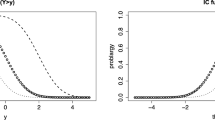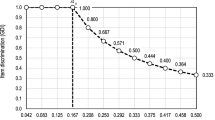Abstract
Probability testing (PT) is a way to respond to multiple-choice test items. In PT the examinee gives to each response option his/her subjective probability of its being correct as an expression of partial knowledge. By using PT more item information can be drawn from the subjects than the other scoring methods that can be used for multiple-choice items. In this research, a multi-dimensional continuous item response model for PT is proposed. Moreover, the matrix of information function, a method of estimating item parameter, a method of estimating the subject’s vector of latent traits are introduced.
Similar content being viewed by others
References
Ben-Simon, A., & Budescu, D. V., & Nevo, B. (1997). A comparative study of measures of partial knowledge in multiple-choice tests. Applied Psychological Measurement, 21, 65–88.
de Finetti, B. (1965). Methods for discriminating levels of partial knowledge concerning a test item. British Journal of Mathematical and Statistical Psychology, 18, 87–123.
Elderton, W. P., & Johnson, N. L. (1969). System of frequency curves. Cambridge: Combeidge University Press.
Hambleton, R. K., Roberts, D. M., & Traub, R. E. (1970). A comparison of the reliability and validity of two methods for assessing partial knowledge on a multiple choice testing. Journal of Educational Measurement, 7, 75–82.
Johnson, N. L., & Kotz, S., & Balakrishnan, N. (1995). Continuous univariate distributions, Vol. 2, 2th ed. New York: John Wiley and Sons.
Kansup, W., & Hakstian, A. R. (1975). A comparison of several methods of assessing partial knowledge in multiple-choice tests: I. Scoring procedures. Journal of Educational Measurement, 12, 212–230.
Lawley, D. N. and A. E. Maxwell. (1971). Factor analysis as a statistical method. (2nd edition) New York: American Elsevier.
Lord, F. M., & Novick, M. R. (1968). Statistical theories of mental test scores. Reading, MA: Addison-Wesley.
Michael, J. C. (1968). The reliability of a multiple choice examination under various test-taking instructions. Journal of Educational Measurement, 5, 307–314.
Press, S. J., & Shigemasu, K. (1989). Bayesian inference in factor analysis. In Gleser, L., & Perleman, M., & Press, S. J. (Eds.), Contributions to probability and statistics. New York: Springer-Verlag.
Pugh, R. C., & Brunza, J. J. (1975). Effects of a confidence weighted scoring system on measures of test reliability and validity. Educational and Psychological Measurement, 35, 73–78.
Rippey, R. M. (1970). A comparison of five different scoring function for confidence tests. Journal of Educational Measurement, 7, 165–170.
Samejima, F. (1974). Normal ogive model on the continuous response level in the multidimensional latent space. Psychometrika, 39, 111–121.
Shuford, E. H., Albert, A., & Massengill, H. E. (1966). Admissible probability measurement procedures. Psychometrika, 31, 125–145.
Suhadolnik, D., & Weiss, D. J. (1983). Effect of examinee certainty on probabilistic test scores and a comparison of scoring methods for probabilistic responses (Research Report 83-3). University of Minnesota, Department of Psychology, Psychometric Methods Program, Computerized Adaptive Testing Laboratory, Minneapolis.
Zhang, Y. P. (2007). An item response model on Probability-Testing. University of Tokyo Press. (in Japanese)
Zhang, Y. P., & Watanabe, H. (2007). Test scoring methods and their problems. IMPS2007.
Author information
Authors and Affiliations
Corresponding author
About this article
Cite this article
Zhang, Y., Watanabe, H. A Multi-Dimensional Continuous Item Response Model for Probability Testing. Behaviormetrika 39, 183–197 (2012). https://doi.org/10.2333/bhmk.39.183
Received:
Revised:
Published:
Issue Date:
DOI: https://doi.org/10.2333/bhmk.39.183




